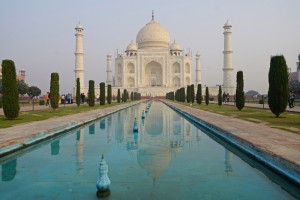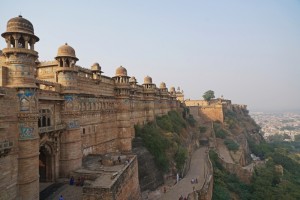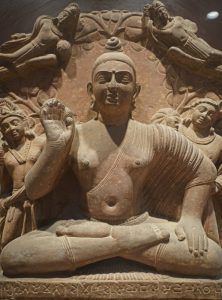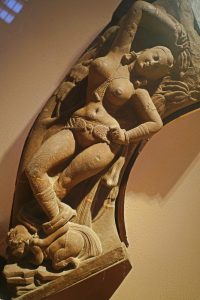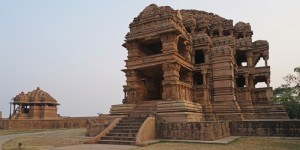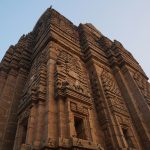November 18 – 21: Delhi, Mathura, Agra, Gwalior & Orchha
Trip Plan
After the pilgrimage trip, I joined Bing, Flora and Siu Mui on an organised 16-day historical deluxe trip from Delhi to Mumbai travelling through Uttar Pradesh (UP), Madhya Pradesh (MP) and Maharashtra. We would visit seven out of the 27 World Heritage Sites in India during this trip.
Background Information
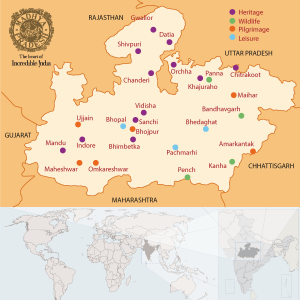 As our trip covered an expansive part of MP and we would visit many Hindu temples, some information of the state and Hinduism is essential. Madhya Pradesh (MP) MP meaning Central Province is the second largest state in India by area (308,525km²) and rich in mineral resources with the country’s largest reserves of diamond and copper. With a population of 75 million, it is the fifth-largest state by population. Bhopal is the capital and the largest city of the state. It boasts three World Heritage Sites manly Khajuraho group of monuments, Buddhist monuments at Sanchi and rock shelters of Bhimbetka. MP is rich in history. Based on some isolated remains unearthed, MP might have been inhabited in the Middle Pleistocene era (i.e. a period of geological time from ca.781 to 126 thousands years ago). The city of Ujjain, capital of the ancient Avanti kingdom, was a major centre in the region during the second wave of Indian urbanisation in 6th century BCE. The region became part of the Mauryan empire, the Gupta empire (4th and 5th centuries) and later broke up into small states ruled by different rulers. The significant ones include the Rashtrakuta Dynasty from the late 8th to the 10th centuries, Paramaras of Malwa and the Chandelas of Bundelk.
As our trip covered an expansive part of MP and we would visit many Hindu temples, some information of the state and Hinduism is essential. Madhya Pradesh (MP) MP meaning Central Province is the second largest state in India by area (308,525km²) and rich in mineral resources with the country’s largest reserves of diamond and copper. With a population of 75 million, it is the fifth-largest state by population. Bhopal is the capital and the largest city of the state. It boasts three World Heritage Sites manly Khajuraho group of monuments, Buddhist monuments at Sanchi and rock shelters of Bhimbetka. MP is rich in history. Based on some isolated remains unearthed, MP might have been inhabited in the Middle Pleistocene era (i.e. a period of geological time from ca.781 to 126 thousands years ago). The city of Ujjain, capital of the ancient Avanti kingdom, was a major centre in the region during the second wave of Indian urbanisation in 6th century BCE. The region became part of the Mauryan empire, the Gupta empire (4th and 5th centuries) and later broke up into small states ruled by different rulers. The significant ones include the Rashtrakuta Dynasty from the late 8th to the 10th centuries, Paramaras of Malwa and the Chandelas of Bundelk.
The Turkic Delhi Sultanate ruled the northern part of the state in the 13th and 14th centuries. After the collapse of the sultanate, independent regional kingdoms re-emerged including the Tomara kingdom of Gwailor and the Muslim sultanate of Malwa with its capital in Mandu. Most part of the MP came under the Mughal rule when the Hindu king Hemu was defeated by King Akbar in 1556. The Mughal control weakened considerably after the death of Emperor Aurangzeb in 1707. Once again the region broke into small states and ruled by different families: Holkars of Indorer ruled much of Malwa, the Scindias of Gwalior controlled the northern parts, Puars ruled Dewas and Dhar, Dost Mohammed Khan, a former general in the Mughal army founded the Bhopal state. The British arrived and finally took control of the entire region with all sovereign states becoming princely states of British India. After the independence of India in 1947, MP was created in 1950. The state boundary of MP was drawn up as a result of the MP Reorganisation Act in 2000.
Hinduism and Hindu Gods
Hinduism is the dominant and native religion of the Indian subcontinent. It equates God with the universe. According to Amrutur V. Srinivasan, it is not an organised religion and has no single, systemic approach to teaching its value system. Local, regional, caste and community-driven practices influence the interpretation and practice of belief throughout the Hindu world. But a common thread among all these variations is belief in a Supreme Being and adherence to certain concepts such as truth, dharma and karma. Belief in the authority of the Vedas (sacred scriptures) serves, to a large extent, as the very definition of a Hindu, evening though how the Vedas are interpreted may vary greatly. The Hindu trinity consists of Brahma(the Creator with wife Sarasvati -Goddess of Learning), Vishnu(the Preserver with wife Lakshmi, Goddess of good fortune, wealth and well-being) and Shiva (the Destroyer with Sati and Parvati as wives). In the Hindu tradition, there are some 3.3 million gods and goddesses.Incarnation is a central theme. Hinduism comprises three major traditions namelySaivism, Vaishnavism and Shaktism whose followers considered Shiva, Vishnu and Shakti (also called as Devi) to be the supreme deity respectively. Most of the other deities were either related to them or different forms (incarnations) of these deities. Popular deities include Ganesha (son of Krishna, the elephant god of wealth and good luck), Hanuman (monkey god, symbol of strength and energy) and Surya (the sun god).
Day 1 November 18 Saturday: Delhi
The pilgrimage trip ended in Kathmandu and we flew to Delhi around 4pm. Bing, Flora and I said good-bye to our Hong Kong friends after landing at the airport at 6pm. They would be getting a connecting flight to Hong Kong at 2am while we began our next journey. As soon as I got off the plane, I was greeted by a Jet Airways staff on the tarmac. He told me he had found my suitcase in the conveyance belt on November 11. He has a nice smile and seems genuinely helpful. I was moved and gave him a tip of 500 rupees. The queue at e-visa counters was short and I got through quickly. I collected my luggage without problem this time. Siu Mui who arrived from Hong Kong around 4pm had been waiting for us for two hours! We were met by a representative from the travel agent ‘My Tour India’ who dropped us to a small family-run Justa GK Hotel in a residential area. The traffic was heavy and we took almost an hour to get to our destination. It was 8pm when we checked in. Siu Mui was my new room mate. I was not too hungry and the menu and the restaurant looked dull. I am not anti-social but decided to skip dinner. Since we had hot water, I was able to have powder congee in the room while Siu Mui, Bing and Flora had dinner downstairs. The hotel though only 8-year-old, looks run-down. The door and corners of the bathroom were covered in dust. The hot water system did not work. We had to ask the receptionist three times to fix it. By the time the water was hot enough for a shower, it was after 10:30pm! Siu Mui had no sleep for 24 hours and was dead tired. We went to bed early and had a reasonable sleep.
Day 2 November 19 Sunday: Delhi – Mathura 165km – Agra 60km
We had a nice breakfast at 8am and departed at 9:30am with our guide Mukesh who is from Khajuraho. Today’s plan was to visit Mathura, the birth place of Krishna, the eight avatar (incarnation) of Vishu, en route to Agra.
According to the legend, Krishna, an eight avatar of Vishu, was the son of Vasudeva and Devaki (sister of Kamsa, wicked king of Mathura). The couple was imprisoned and their offspring was slaughtered by Kamsa who feared his kingdom would one day be destroyed by Devaki’s child. When Krishna was born, he was smuggled across the Yamuna River by a servant to Gokula (modern day Gokul) where he was raised by Nanda (leader of the herdsman)and his wife Yashoda. Krishna grew up performing many miracles and slew demons. He became renowned as a lover and the sound of his flute would prompt gopis (wives and daughters of headsmen) to leave home to dance ecstatically with him in the moonlight. When he grew up and learned about his parents, he and his brother Balarama returned to Mathura and slayed Kamsa. He led his Yadavas clan move west and established his court at Dvaraka (modern day Dwarka, Gujarat) and marred the princess Rukmini and took other wives. He was shot and killed by a huntsman mistaking him for a deer in a forest when he sat lamenting the death of his brother and son. The rich variety of legends associated with Krishna’s life has led to an abundance of representation in painting and sculpture. The child Krishna is depicted crawling on his hands and dancing with joy. The divine lover is shown playing the flute surrounded by adoring gopis. He is also depicted with blue-black skin, wearing a yellow dhoti (loincloth) and a crown of peacock feathers.
We arrived at the Krishan’s temple after 1pm. No photo is allowed in the temple ground. Mukesh took us to the cell where the couple was imprisoned and where Krishna was born. We also entered a cave which tells his life story. The cave was stuffy and children were making a lot of noises. I soon got out gasping for fresh air. It was after 2pm when we finished the tour. We had a quick lunch in a local eatery. A set lunch (typical thali ) with chapati, dil, potato and rice cost 80 rupees. As some political party was campaigning in the area, our minibus could not go to the Archaeological Museum. We had to take a tuk-tuk and were amazed to find many awesome stone sculptures in good conditions ranging from the third BCE to the Medieval Period around 16th century. The museum was closed at 4:30pm. I only saw a small portion of the exhibits. Anyway, I took many photos which I could look more closely later.
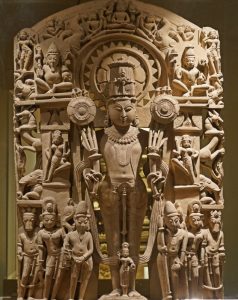 By the time we arrived at the Howard Plaza Hotel in Agra, it was already 7pm. We were hungry and had dinner at the hotel. The buffet was good and reasonable (less than US$10 pp with discount for hotel guests). I was not tired and spent a couple of hours on my travel notes for the first time.
By the time we arrived at the Howard Plaza Hotel in Agra, it was already 7pm. We were hungry and had dinner at the hotel. The buffet was good and reasonable (less than US$10 pp with discount for hotel guests). I was not tired and spent a couple of hours on my travel notes for the first time.
Day 3 November 20 Monday: Taj Mahal; Agra to Gwalior by train
Taj Mahal meaning Crown of the Palace, is India’s icon and the country’s most visited attraction with some 4 million visitors a year.Emperor Shan Jahan (reigned from 1628 to 1658) commissioned a project in 1632 to house the tomb of his favourite wife, Mumtaz Mahal who died of childbirth. The tomb is the centrepiece of a 17-hectare complex which include a mosque, a guest house, gardens and fountains. The project deployed some 20,000 artis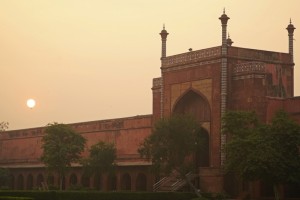 ans and cost 32 million rupees. It has been designated as a World Heritage Site for being “the jewel of Muslim art in India and one of the universally admired masterpieces of world heritage”.
ans and cost 32 million rupees. It has been designated as a World Heritage Site for being “the jewel of Muslim art in India and one of the universally admired masterpieces of world heritage”. 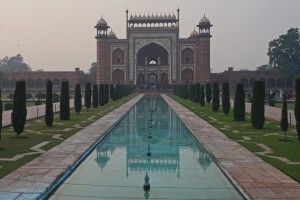
According to Mukesh’s plan, we would leave for Taj Mahal at 6:15am, have breakfast in the hotel and then depart for the train station after 9am. Siu Mui who washes her hair every morning, planned to get up at 5:30am. But she forgot to set the alarm. Nor had I! We were shocked when the phone ranged at 6:15am. We jumped up, brushed our teeth, put on our clothes and arrived at the lobby in less than ten minutes’ time. What a record! We arrived at the west gate entrance just after 6:30am and waited for about 30 minutes for body and bag search. Only two young ladies were on duty and some rude local guys jumped queue. By the time we entered through the majestic main gate, the sun was already above the tree line.
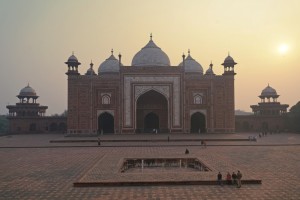
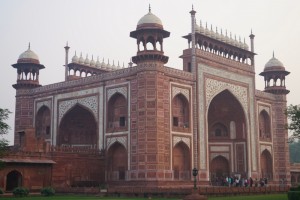 This is my third visit and I am familiar with the story though I keep forgetting the details. But it does not matter: I always enjoy looking at beautiful things and enjoying the atmosphere. If I learn something new, it is a bonus. But our local guide who claims to have 25 years’ experience, is boring and condescending. His voice is dull, his accent is not easy to follow and he essentially repeats what can be found in the information board! Soon I asked him the meeting point and time at the end of the tour. While my friends were posing for the photos, I returned to the main entrance to take a panoramic photo of the eternal monument. I then saw them walking down the garden path. Soon I lost sight of them. But there is only one way to the mausoleum. Eventually I saw them under some trees in an invisible path off the main path. The guide is stupid. If he takes a side path, how can he expect me to see the group! Bing was crossed as they had been wasting time waiting for me. I wish I had trust my instinct and told the guide I would meet the group at the finishing point at an agreed time.
This is my third visit and I am familiar with the story though I keep forgetting the details. But it does not matter: I always enjoy looking at beautiful things and enjoying the atmosphere. If I learn something new, it is a bonus. But our local guide who claims to have 25 years’ experience, is boring and condescending. His voice is dull, his accent is not easy to follow and he essentially repeats what can be found in the information board! Soon I asked him the meeting point and time at the end of the tour. While my friends were posing for the photos, I returned to the main entrance to take a panoramic photo of the eternal monument. I then saw them walking down the garden path. Soon I lost sight of them. But there is only one way to the mausoleum. Eventually I saw them under some trees in an invisible path off the main path. The guide is stupid. If he takes a side path, how can he expect me to see the group! Bing was crossed as they had been wasting time waiting for me. I wish I had trust my instinct and told the guide I would meet the group at the finishing point at an agreed time.
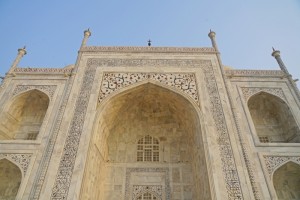 I was overwhelmed when I first saw Taj Mahal on my first visit in 1978. The sky was blue and the white marble glowed in the sunlight. We were able to walk freely and take pictures inside the mausoleum. The place was serene, tranquil and atmospheric with few tourists. Today, mass tourism has spoilt the crown jewel and I do not enjoy my third visit. First, the crowd control management including the queuing, body and bag search was cumbersome and unpleasant. Second, it was dim inside the mausoleum. The soft lighting by sun rays filtering through the translucent and beautifully carved marble had gone. Third, visitors have to walk in single file on a narrow railed path. Of course no photo is allowed. Finally, the magnificent and splendid white marble structure looked sorrowful in smog. I took a last look at the it and wondered whether I would ever return.
I was overwhelmed when I first saw Taj Mahal on my first visit in 1978. The sky was blue and the white marble glowed in the sunlight. We were able to walk freely and take pictures inside the mausoleum. The place was serene, tranquil and atmospheric with few tourists. Today, mass tourism has spoilt the crown jewel and I do not enjoy my third visit. First, the crowd control management including the queuing, body and bag search was cumbersome and unpleasant. Second, it was dim inside the mausoleum. The soft lighting by sun rays filtering through the translucent and beautifully carved marble had gone. Third, visitors have to walk in single file on a narrow railed path. Of course no photo is allowed. Finally, the magnificent and splendid white marble structure looked sorrowful in smog. I took a last look at the it and wondered whether I would ever return.
We were back in the hotel by 8:30 am. I packed, had breakfast and was ready to leave at 9:10 am. Unfortunately, the train service remains slow and unreliable. Our train scheduled for 9:40 am was late and we did not leave till 11:15 am. We had assigned seats in a compartment with air conditioning. But the seats are dirty and not comfortable. The toilet is smelly and water is running at the landing.
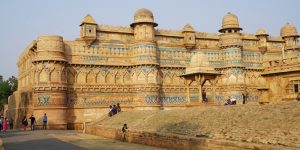
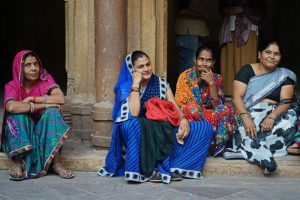 We were delighted to get off at the Gwalior train station at 1:30pm. We were met by our driver Raja and his assistant Raju and proceeded to check in the Clarks Inn. To save time, we had cup noodles in our room so that we could set off as soon as possible. Historically and architecturally, Gwalior is interesting first as an ancient seat of Jain worship; second for its example of palace architecture of the Ilindu period between 1486 and 1516; and third as an historic fortress. I was relieved when we were met by a young local guide at the Gwalior Fort. He speaks good English without funny accent and is efficient and informative. He briefly outlined the history of Gwalior which had been ruled by several historic northern Indian kingdoms including the Tomars in the 13th century.
We were delighted to get off at the Gwalior train station at 1:30pm. We were met by our driver Raja and his assistant Raju and proceeded to check in the Clarks Inn. To save time, we had cup noodles in our room so that we could set off as soon as possible. Historically and architecturally, Gwalior is interesting first as an ancient seat of Jain worship; second for its example of palace architecture of the Ilindu period between 1486 and 1516; and third as an historic fortress. I was relieved when we were met by a young local guide at the Gwalior Fort. He speaks good English without funny accent and is efficient and informative. He briefly outlined the history of Gwalior which had been ruled by several historic northern Indian kingdoms including the Tomars in the 13th century. 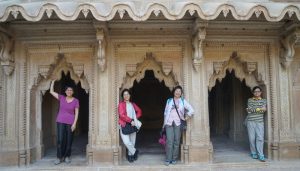
It was part of the Mughal Empire and was captured by the Scindias since 1730. It remained a princely state during the British rule till Indian independence in 1947. The fort built during the Tomara dynasty, has been described as one of the most structurally sound forts of India. It overlooksthe city. Inside the fort, the major attraction is the Maan Mandir Palace built by Raja Man Singh. We only covered a small corner of the palace looking at the music /dancing hall and courtyard, a praying room and the Raja’s chamber. The architecture is unique displaying a Chinese influence on Indian architecture. Our guide pointed at a couple of Chinese dragons crafted at the hilt of the pillars. The sun was setting and we hurried to see a few more sites.
We first stopped at the 9th century shrine Sas Bahu Ka Mandir (Mother-in-law and Daughter-in-law temples), a 9th -century shrine. The larger one is dedicated to Vishnu with beautiful carvings and sculptures. The roof is adorned with a marvelous lotus carving. As there were many visitors when we entered, I decided to take a quick look at the smaller temple dedicated to Shiva first. My strategy worked: when I returned to see the Vishnu temple, I was alone!
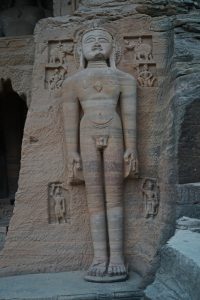 Next we visited Teli Ka Mandir (‘oil-man’s temple’) a structure of over 30m high. The architecture follows the Indo-Aryan and Nagara styles. The roof of the temple holds a Dravidian look though the sculptures are typically North Indian.
Next we visited Teli Ka Mandir (‘oil-man’s temple’) a structure of over 30m high. The architecture follows the Indo-Aryan and Nagara styles. The roof of the temple holds a Dravidian look though the sculptures are typically North Indian.
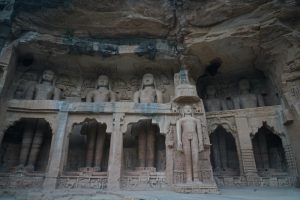 We then walked downhill to look at a series of Jainism-related cave monuments carved into the rock face by the Tomar kings. Located in the mountainous terrain on the slope of the fort, the statues depict all 24 Tirthankaras of Jainism. They are shown in naked form in both seated Padmasana posture as well as standing Kayotsarga posture. The tallest one is 17m high. The statute of Parshvanath seated on a lotus was carved out of a single stone (47ft in height and 30ft in breadth), is the largest of its kind in the world. It was dark when we were back in the hotel. We went to the mall next door and had Indian food in the classy Man Shing Restaurant. We paid 1700 rupees for a decent dinner with three dishes and drinks.
We then walked downhill to look at a series of Jainism-related cave monuments carved into the rock face by the Tomar kings. Located in the mountainous terrain on the slope of the fort, the statues depict all 24 Tirthankaras of Jainism. They are shown in naked form in both seated Padmasana posture as well as standing Kayotsarga posture. The tallest one is 17m high. The statute of Parshvanath seated on a lotus was carved out of a single stone (47ft in height and 30ft in breadth), is the largest of its kind in the world. It was dark when we were back in the hotel. We went to the mall next door and had Indian food in the classy Man Shing Restaurant. We paid 1700 rupees for a decent dinner with three dishes and drinks.
Day 4 November 21 Tuesday: Gwalior – Datia 77km – Orchha 49km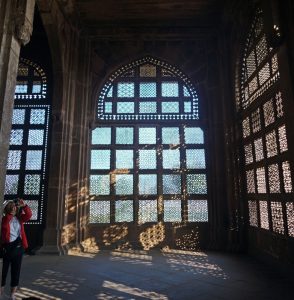
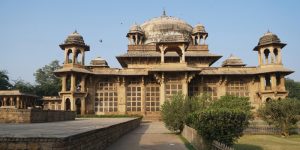 We had a busy day. First we went to the mausoleum of the 16th century Sufi Saint Ghous Mohammedand the tomb of Mian Tansen(c1500-1586). The former was the teacher of Mughal Emperor Humayun as well as Tansen who was a poet, musician, composer and singer. The Mughal Emperor Akbar considered Tansen a Navaratnas (nine jewels) and gave him the title Mian, an honorific meaning learned man.
We had a busy day. First we went to the mausoleum of the 16th century Sufi Saint Ghous Mohammedand the tomb of Mian Tansen(c1500-1586). The former was the teacher of Mughal Emperor Humayun as well as Tansen who was a poet, musician, composer and singer. The Mughal Emperor Akbar considered Tansen a Navaratnas (nine jewels) and gave him the title Mian, an honorific meaning learned man.
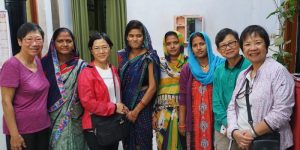 I had asked Mukesh the day before to arrange a home visit if possible. He kindly arranged us to visit his cousin’s family in Gwalior. His cousin’s husband met us up at the mausoleum. In India, an extended family often lives under the same roof. In this case, the father and mother both in their 50s live with their three married sons, their wives and three grandsons. Each son has a room for his family while the parents occupy the living room. They can build a second floor providing a few more rooms. The three daughters-in-law share the household chores. If things work out well without personal conflicts, it could be a wonderful communal living! They served us home-made marsala tea and food. A great cultural experience! We said good-bye to our host and left around 11:30am.
I had asked Mukesh the day before to arrange a home visit if possible. He kindly arranged us to visit his cousin’s family in Gwalior. His cousin’s husband met us up at the mausoleum. In India, an extended family often lives under the same roof. In this case, the father and mother both in their 50s live with their three married sons, their wives and three grandsons. Each son has a room for his family while the parents occupy the living room. They can build a second floor providing a few more rooms. The three daughters-in-law share the household chores. If things work out well without personal conflicts, it could be a wonderful communal living! They served us home-made marsala tea and food. A great cultural experience! We said good-bye to our host and left around 11:30am.
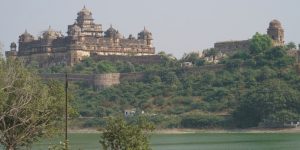
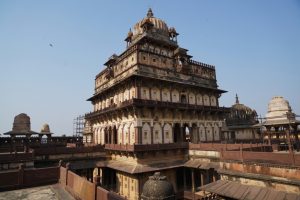 Our next destination was Datia once an important market centre for food grains and cotton products with hand loom weaving an important industry. The main attraction here is the seven-storied palace built in 1614 by Vir Singh Deo, a Bundela Raiput chief who ruled the kingdom of Orchha between 1605 and 1626 (or 1627) and built 52 monuments. He was a vassal of the Mughal Empire. This palace is the biggest and most famous one built by the raja though it was used only once for one night by a Mughal king. The local guide talked a lot but I found his accent a distraction. I gave up and spent time looking around and taking photos. He left me alone and I was never far behind the group. Peaceful co-existence!
Our next destination was Datia once an important market centre for food grains and cotton products with hand loom weaving an important industry. The main attraction here is the seven-storied palace built in 1614 by Vir Singh Deo, a Bundela Raiput chief who ruled the kingdom of Orchha between 1605 and 1626 (or 1627) and built 52 monuments. He was a vassal of the Mughal Empire. This palace is the biggest and most famous one built by the raja though it was used only once for one night by a Mughal king. The local guide talked a lot but I found his accent a distraction. I gave up and spent time looking around and taking photos. He left me alone and I was never far behind the group. Peaceful co-existence!
We moved on after spending an hour in Datia and arrived after 4pm in Orchha located along Betwa River. Founded in the 16th century by the Bundela Rajput chieftain Rudra Pratap, Orchha meaning ‘hidden place’ is a hidden jewel full of impressive palaces and temples built by Bundela kings in the 16th and 17th centuries.
According to the Hindu tradition, Vishnu descends in form of an avatar to restore cosmic order. Dashavatara refers to Vishnu’s ten primary avatars (incarnations) namely Matsya (fish), Kutma (tortoise), Varaha (boar), Narasimha (man-lion), Vamana (dwarf), Parashurama, Rama, Krishna, Buddha and Kakli (yet to happen and the saviour).
We met an experienced guide outside the Raj Mandir. Our guide mainly showed us one of the rooms with colourful murals relating to Dashavatara. The palace though simple, looks interesting. 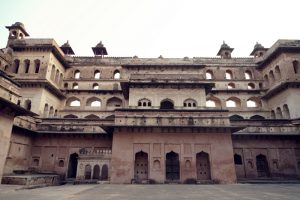 But we spent less than 30 minutes before moving on to the nearby Jahangir Mahal (or the Citadel of Jahangir) dating to the 17th century built by Vir Singh Deo as a symbol of warm reception of the Mughal Emperor Jahangir during his first visit to the city.
But we spent less than 30 minutes before moving on to the nearby Jahangir Mahal (or the Citadel of Jahangir) dating to the 17th century built by Vir Singh Deo as a symbol of warm reception of the Mughal Emperor Jahangir during his first visit to the city. 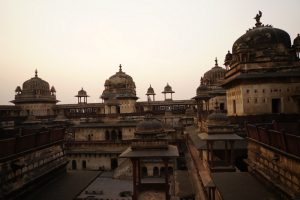
The palace/citadel is a magnificent example of Hindu architectural design. The entrance is marked by an artistic and traditional gateway. The three-storied building was built on a rectangular base and relieved by a circular tower at each corner surmounted by a dome with many hanging balconies, porches and apartments. A large pool is situated in the centre of the courtyard. The front wall of the structure facing east is covered with turquoise tiles. We watched a fantastic sunset on the top floor of the palace.
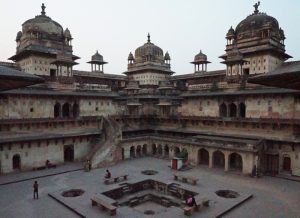 Mukesh suggested us have a vegetarian dinner before going to Ram Raja Temple around which the life of Orchha revolves. The presiding god is Bhagwan Ram. We watched devotees streaming into the courtyard. At 7pm sharp, the priest opened the door of the chamber so that devotees could see the revered Bhagwan Ramand a few idols. Devotees could also watch the rituals from TV screens. They prayed frantically and loudly and threw offerings to the gods. After ten minutes, devotees could go inside to seek blessing from the priest. I followed the crowd and the priest sprinkled water into my palm. I put the water on my forehead. No photo was allowed.
Mukesh suggested us have a vegetarian dinner before going to Ram Raja Temple around which the life of Orchha revolves. The presiding god is Bhagwan Ram. We watched devotees streaming into the courtyard. At 7pm sharp, the priest opened the door of the chamber so that devotees could see the revered Bhagwan Ramand a few idols. Devotees could also watch the rituals from TV screens. They prayed frantically and loudly and threw offerings to the gods. After ten minutes, devotees could go inside to seek blessing from the priest. I followed the crowd and the priest sprinkled water into my palm. I put the water on my forehead. No photo was allowed.
It was late when we checked in Amar Mahal, a beautiful luxurious hotel built in the style of a palace with rooms spreading around two central courtyards. Unfortunately, we did not have time to relax or enjoy the hotel.


